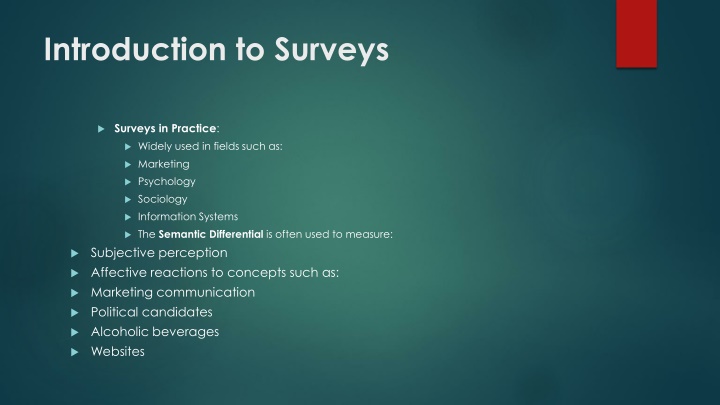
Surveys: Applications, Types, Questions, and Data Analysis
Learn about the practical applications of surveys in various fields, types of surveys, different question types, common errors and biases, data analysis techniques, and a case study on Electric Vehicle adoption survey with key findings and impact.
Download Presentation

Please find below an Image/Link to download the presentation.
The content on the website is provided AS IS for your information and personal use only. It may not be sold, licensed, or shared on other websites without obtaining consent from the author. If you encounter any issues during the download, it is possible that the publisher has removed the file from their server.
You are allowed to download the files provided on this website for personal or commercial use, subject to the condition that they are used lawfully. All files are the property of their respective owners.
The content on the website is provided AS IS for your information and personal use only. It may not be sold, licensed, or shared on other websites without obtaining consent from the author.
E N D
Presentation Transcript
Introduction to Surveys Surveys in Practice: Widely used in fields such as: Marketing Psychology Sociology Information Systems The Semantic Differential is often used to measure: Subjective perception Affective reactions to concepts such as: Marketing communication Political candidates Alcoholic beverages Websites
Surveys A method of collecting data from a group of respondents. It is used to gather opinions, behaviors, or factual information
Types of Surveys Cross-sectional Surveys Data collected at a single point in time Longitudinal Surveys Data collected over time (e.g., panel studies, cohort studies) Descriptive Surveys Describe characteristics of a population Analytical Surveys Investigate relationships between variables
Types of Questions Open-ended vs. Closed-ended Likert scale (e.g., Strongly Agree to Strongly Disagree) Multiple-choice Ranking questions
Common Survey Errors & Biases Sampling Bias Not representing the population correctly Response Bias People answering dishonestly or inaccurately Non-Response Bias When certain groups do not respond Question Wording Effects Poorly framed questions leading to misinterpretation
Data Analysis in Surveys Descriptive Statistics: Mean, Median, Mode, Frequency distribution Inferential Statistics: Hypothesis testing, Regression analysis Visualization: Graphs, Charts, Heatmaps
Case Study: Electric Vehicle (EV) Adoption Survey Objective: To understand consumer perception, challenges, and acceptance of electric vehicles (EVs). Methodology: Surveyed 10,000+ consumers across different regions. Questions focused on charging infrastructure, cost, battery range, and environmental benefits.
Findings and Impact 60% of respondents were concerned about charging stations availability. High battery cost was a major factor slowing adoption. Government incentives increased willingness to buy Evs Helped policymakers design better EV incentives Led to expansion of fast-charging networks. Pushed companies to invest in battery technology improvements.
Semantic Difference Scale It measures the subjective perception of and affective reactions to more specific concepts 3 2 1 0 -1 -2 -3 Heavy Light Hot Cold Strong Weak Active Passive
Likert Scale Strongly Agree Agree Undecided Disagree Strongly Disagree
Staple Scale +5 +5 +5 +4 +4 +4 +3 +3 +3 +2 +2 +2 +1 +1 +1 Tasty Food Fast Service Good Ambience -1 -1 -1 -2 -2 -2 -3 -3 -3 -4 -4 -4 -5 -5 -5
Design a set of 15 questions for a survey on any one of the following topics: Renewable Energy Adoption and Challenges Artificial Intelligence (AI) in Daily Life Electric Vehicle (EV) Adoption & Infrastructure 3D Printing in Engineering & Medicine Water Conservation & Smart Irrigation Cybersecurity Awareness & Digital Privacy Space Exploration & Public Opinion on Mars Colonization

